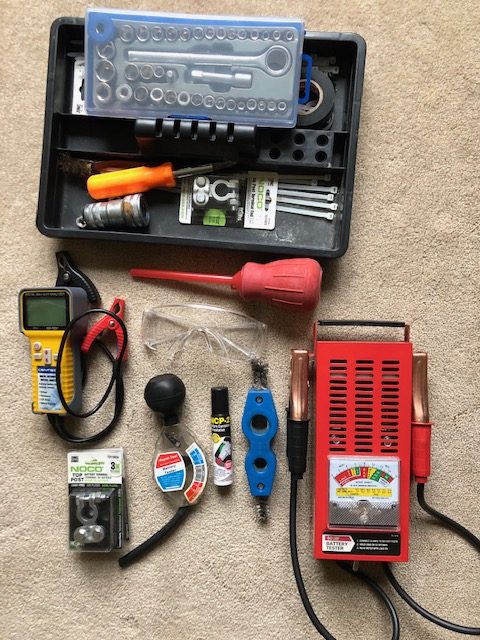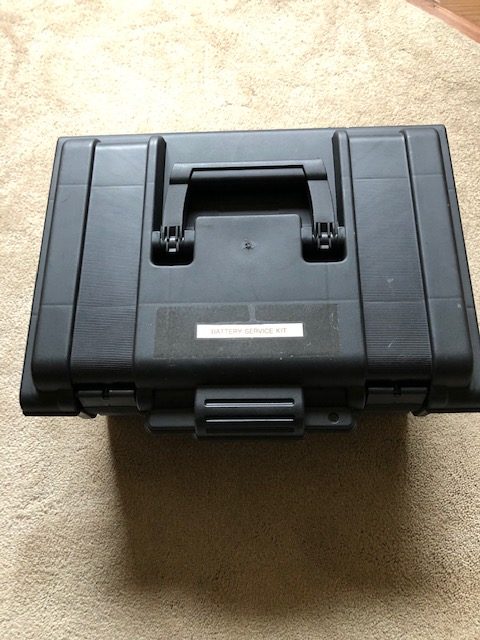Over on the Off Grid Ham affiliate Google Groups.io forum a reader asked a question about how to properly maintain flooded batteries, also referred to as wet cell batteries. We have addressed this topic before but as a result of recent interest it’s a good time for a flooded batteries refresher course.
Safety first.
Safety gear for flooded batteries is not expensive or hard to find. You probably already own most of this stuff. Here’s what you’ll need:
- Safety glasses.
- Acid-resistant rubber gloves. Leather works good too.
- Long sleeve shirt, long pants, and shoes that you don’t mind being ruined.
- A box of common household baking soda.
- Rags/towels.
- Water –tap water is fine.
You’re going to get sulfuric acid on you. It’s almost unavoidable. You may not notice right away when acid gets on your clothes. After a while, holes will appear. Leather seems to hold up well.
You also may not immediately notice if the acid gets on your skin. An itchy/burning sensation will come on slowly. Rinse any exposed skin with water. If there are any visible injuries or the itch/burn does not stop, seek medical help.
Neutralize spilled acid with the baking soda.
Flooded batteries give off very explosive hydrogen gas. Make sure you are working in a well ventilated area. It should not need saying but I’ll say it anyway: No smoking, sparks, or open flames!
The bottom line.
Working safely with flooded batteries does not require a lot of knowledge or training. The key concepts are: Do not allow any contact with the sulfuric acid, vent away the hydrogen gas, and eliminate electric shock hazards. If you do those three things you’ll be fine.
Tools & equipment.
The tools & equipment needed for maintaining flooded batteries is mostly simple stuff. More advanced amateurs will want additional items but here are the basics:
- Multimeter.
- Screwdriver.
- Adjustable wrench, pliers, open ended wrenches, or Vise-grips.
- Wire brush.
- Spray-on anti corrosive compound (auto parts store).
- Hydrometer (auto parts store).
- Distilled water.
- Funnel or measuring cup.
- Optional: Load tester.
Additional information.
Auto parts stores have brushes made specifically for flooded batteries.
Spray on anticorrosive compound avoids corrosion on terminals. Some old timers use a water & baking soda mixture to clean battery terminals. This method removes the crud that’s already there but will not prevent corrosion going forward.
Use only distilled water in flooded batteries. Never use tap water, home filtered tap water, nursery water, or other bottled waters. Everything except distilled water has minerals and trace additives that will contaminate your battery.
The hydrometer.
The hydrometer is such a handy tool that it gets special mention. Battery and off grid retailers sell hydrometers for $30.00 and even more. You don’t need to spend that much. Hydrometers are available on line or at any auto parts store for less than twenty bucks. Make sure you get one for testing batteries because there are also hydrometers for automotive coolant and other liquids and they all basically look the same.
A hydrometer is the only practical way to check individual cells within the battery. The principle is very simple: As a flooded battery charges and discharges, the density of the acid changes. By measuring this density, you can very accurately determine the state of charge.
If everything is right, all the cells should have about the same density. If the densities are all over the place, your battery may need to be equalized.
Equalizing is the process of bringing each cell to the same state of charge. This is also referred to as balancing. Some of the better battery chargers and solar controllers have an equalize setting. The process can take several hours. When the equalization cycle is complete, check the fluid densities again. If they all closely line up, then you are good to go. Your battery may need to be replaced if the hydrometer still shows one or more cells are undercharged. At the very least, it has diminished capacity.
Here is a handy chart to interpret density readings.
Taking care of business.
Regular maintenance on flooded batteries should be done at least twice a year, or quarterly if your batteries are cycled often.
The procedure is simple. Start with a fully charged battery. After taking appropriate safety precautions, check the voltage of the batteries with a multimeter. Record the reading. Carefully check the exterior of the battery for cracks, bulges, fluid leaks, and any abnormal conditions. Use the wire brush to clean the terminals. Wire brushing may not be needed if you used anticorrosive compound when initially installing the batteries.
Pop open the filler ports on your batteries. Look inside and verify the fluid levels. Then check each cell’s state of charge with the hydrometer. If the fluid levels are really low, you may not be able to draw enough up to get a reading. That’s not good! If you encounter this situation, fill the cell per instructions below. Do not check the density with the hydrometer until the battery has gone through a charge cycle. You will not get a meaningful reading immediately after filling a cell with a large volume of water.
Low fluid levels can be caused by one or more of several things:
- Excessive heat
- Overcharging
- Cracked or damaged case
- Filler caps not properly installed
- Battery not sitting on a level surface
- Infrequent/improper maintenance
Fill ‘er up.
Use a funnel or a cup with a spout to top off each cell with distilled water to just below the filler port. Completely immerse the plates in fluid. Do not tap, hit, or rock the battery in an effort to release excess gas bubbles. “Burping” a battery serves no useful purpose. It can crack the case or cause internal damage. Wipe up any spilled fluid and reseal the battery.
After the battery charges, check the voltage again. It should be equal to or greater than than the voltage recorded at the beginning of the procedure.
What we learned today.
- Flooded batteries need ongoing maintenance for maximum capacity and service life
- Sulphuric acid and hydrogen gas can be very dangerous and requires some simple but important safety precautions.
- A hydrometer is the only practical way to determine the state of charge in specific cells of flooded batteries.
- Equalizing or balancing is the process of bringing each cell to the same state of charge.
- Service your flooded batteries every six months, or every quarter if they are in a harsh environment or cycled often.
Resources:
This Off Grid Ham article from August 2016 gives additional information about flooded batteries.
The Off Grid Ham affiliate Google Groups.io forum –readers can post questions, answer questions posted by others, and connect with other readers. This is a new feature. Please join us!


Here’s an alternative to using baking soda and water to remove battery acid
First, make certain that the battery’s vent caps are tight.
Second, pour Coca-Cola or Pepsi on the corrosion. It works as well as bkaing soda and water. (Something in the cola syrup neutralizes sulphuric acid. I’m told that cola syrup is highky alkaline).
Of course a thrifty HAM would use the store brand cola.
Finally, rinse off the mess with water.
I used this trick years ago when on a trip my pickup’s alternator went bad and the battery burped acid over itself and the tray. Not having baking soda or a brush I used cola I had in the cooler. I used my drinking water to rinse off the mess.
Lew, N9WL
Lew- Corn syrup’s pH is about 3.5 to 5.5, so that would make it acidic. Anything below 7 is acidic, above 7 is alkaline. In fact, a lot of soft drinks like Coke, Pepsi, Mountain Dew, etc. actually add phosphoric acid to the mix. So it wouldn’t neutralize the battery acid, but it would, along with the water you used, flush it off the surface of the battery and tray. One of the reasons soda is so bad for teeth is the acids in the stuff, not just the sugar.
I’ve heard of the “Coca-Cola trick” but I’m more inclined to believe it’s an old shop tale than something that actually works. As Randall explains, the chemistry does not add up. There is also the possibility that the Coke will get into electrical connections and create a bigger problem than it solved. Maybe it works? I can’t say for sure. With so many other easier and proven effective methods, why bother?
Great information, Chris. A lot of people forget about the fact that batteries need maintenance and proper care. When I worked for the school district we ran battery operated equipment like big floor scrubbers, sweepers, etc, usually 24 or 48 volt equipment with massive 6 volt deep cycle batteries that were very expensive. The cleaning crew was supposed to be responsible for checking the batteries on the equipment every night at the end of their shift, but when we started to get complaints that the batteries had lost capacity I started checking and found they were just plugging the equipment into the chargers and not checking anything. They’d cooked the batteries dry in one big floor scrubber costing us several thousand dollars in replacements and obviously weren’t checking the batteries in the other equipment. After that it became my job to check the batteries, charging systems, etc. every day. It’s amazing how much water those things can require. I think I went through about 3 gallons of distilled water every week.
Your experience reinforces what I mentioned in the article: Batteries that are used a lot or in harsh environments need more attention. My home battery bank is past its useful life and needs to be replaced. I’m seriously considering moving to sealed AGM batteries to reduce the maintenance hassles.
I really like AGM batteries. I’ve been running them in my motorcycles for many years now and never had any problems with them. They seem to have a longer life span than standard lead acid batteries, but that can vary widely depending on how they’re charged, heat, etc. I also had one in my Jeep. They’re great for applications where the battery might get into positions where it could spill acid, like motorcycles and off road vehicles. They’re becoming more common in cars now, especially the ones with auto stop/auto start systems, because they can handle the rapid charge/discharge better. They also last longer in deep cycle situations than do standard lead acid. They’re more expensive, but considering the advantages I think they’re worth the extra cost. A couple of “gotchas”, though. They don’t like heat. Most manufacturers recommend they be installed away from engines and other heat sources. They also don’t like overcharging so some caution is needed when selecting a battery charger. But most modern ‘smart’ chargers can handle them with no problem. For a home back up power situation I’d certainly put them at the top of the list.